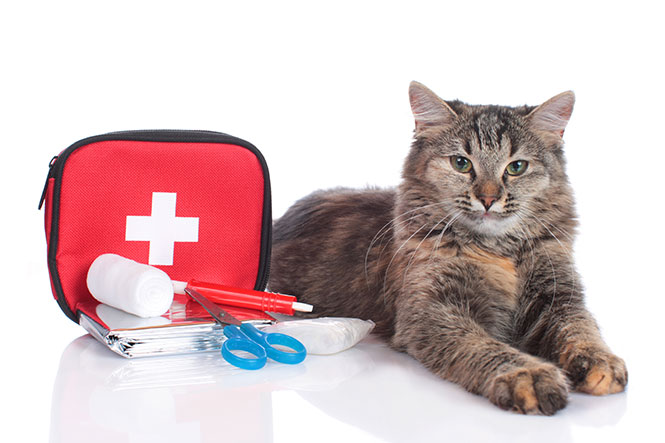You’ve walked in the front door to find bloody pawprints leading down the hall. What do you do?
You’ve taken pooch out for what you thought would be a calm and relaxing walk only to run into a vicious dog. What do you do?
Your cat’s had a run in with a snake on the lawn. What do you do?
Just like humans, pets can suffer injuries anytime and anywhere and just as you may rely on a friend to bandage your wound, your pet relies on you. Could you handle it if something went wrong or would you let them down? How you act in the immediate moments following an accident can mean the difference between life and death, so are you prepared?
As a pet owner, it’s your responsibility to ensure you are well-equipped when accidents strike. This means enrolling yourself in a pet first aid course, such as those offered by the Pet Industry Association (PIA) and building yourself a customised first aid kit.
Pet First Aid Workshops
Many institutions in Australia offer a variety of hands-on, practical courses to help you deal with emergency situations. Available all over the country, each course varies, but topics you can expect to cover include:
- Clear responsibilities of the first aider
- Individual handling requirements of companion animals
- Risk management
- Signs of ill health
- Identifying an emergency
- Safe moving techniques for injured animals
- Cardiopulmonary resuscitation
- Bandaging techniques for various applications
- DRABC action plan (Danger, Response, Airway, Breathing, Circulation)
- Safe restraint and transportation
You will learn about common pet injuries, such as:
- Lacerations and bite wounds
- Torn nails
- Insect bites and stings
- Pet abrasions
- Eye trauma
- Punctures
- Foreign objects
- Snake bites
Building a First Aid Kit
While it is always recommended that your pet visits your vet following an accident, there are a number of ways you can assist your injured pet before transporting them. To do this, you will need a first aid kit.
First aid kits may be purchased from the Animal Welfare League, with each kit containing 30 specialty pieces for quick and easy first aid administration. You can also find basic first aid kits in most pet supply stores. Alternatively you could build your own.
Items you will need in your first aid kit include:
Basic first aid supplies
- Absorbent gauze pads
- Sterile non-stick gauze pads
- Gauze rolls
- Adhesive tape (preferably 1” medical tape)
- Antiseptic wipes
- Blanket (preferably a foil emergency thermal shock blanket)
- Cotton balls or swabs
- Instant ice pack
- Non-latex disposable gloves
- Scissors
- Saline solution
- Needle-nosed pliers or tweezers
Pet-specific supplies
- Pet first aid book
- Phone numbers for your veterinarian or the nearest emergency vet clinic and the poison-control centre
- Paperwork for your pet, including vaccination status, important medical history and a current photo
- Nylon leash
- Self-cling bandage (one that sticks to itself rather than pet fur)
- Muzzle or strips of cloth that can be used to prevent biting (not to be used if vomiting, choking, or having difficulty breathing)
- Hydrogen peroxide (to induce vomiting when instructed by a veterinarian or poison control expert)
- Vet-prescribed pain relief
Other optional items
- Ear cleaning solution
- Sample credit card (or a similar unimportant card) to scrape away insect stings
- Nail clippers
- Glucose paste or corn syrup (for diabetic dogs or those with low blood sugar)
- Penlight or flashlight
- Plastic eyedropper or syringe
- Splints
- Tongue depressor
- Temporary identification tag
- Towel
- Wound disinfectant such as Betadine
- Rehydrating solution such as Gatorade
- Anti-diarrheal medicine such as Pet Pectate
- Diphenhydramine (Benadryl) for allergic reactions
- Activated charcoal to absorb ingested poisons
- Rectal thermometer and water-based petroleum jelly to lubricate
- Pet carrier
- Hemostatic device to accelerate natural clotting and stop bleeding fast
There is no one-size-fits-all approach to pet first aid kits, so talk to your veterinarian about what you should have in yours. Having a first aid kit that has been customised to suit your pet is the best way in which to ensure you are well prepared in an emergency.
Different species, age groups, and pet lifestyles have different first aid kit needs. Pets who take medication regularly should have a couple of days supply of all current medications (be sure to rotate so they don’t expire).
Note: It is easy to forget first aid training when faced with an emergency, especially when it involves your best friend, therefore it is recommended that you download VetWest’s FREE First Aid for Pets app on your phone to complement your customised first aid kit. Written by Australian vets to provide both accuracy and relevance it will help you when you need it most. You’ll find 130 helpful and potentially life-saving articles for quick reference in the event of an emergency or potential health risk. Download it today.







Leave A Comment